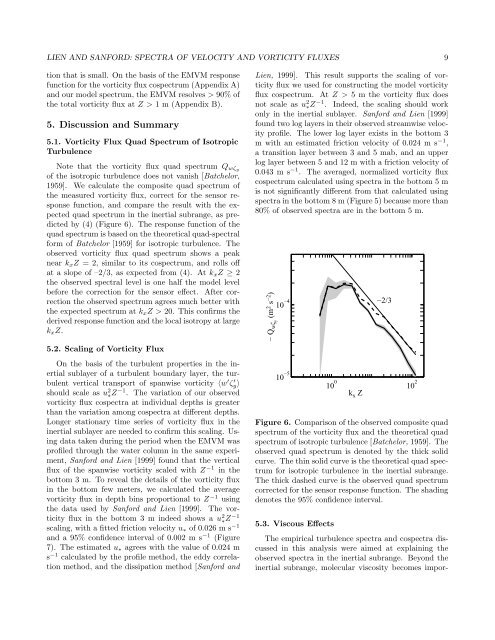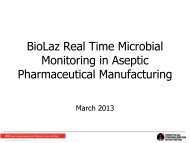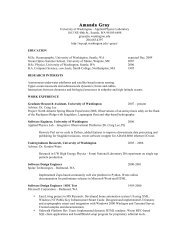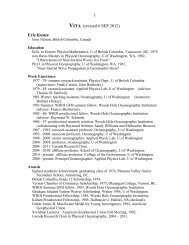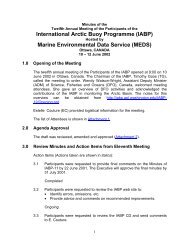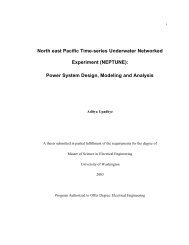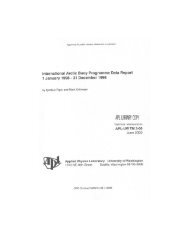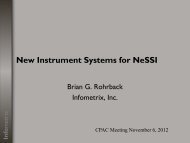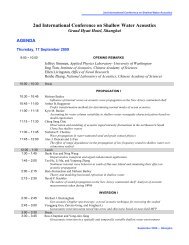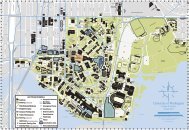Spectral characteristics of velocity and vorticity fluxes in an ...
Spectral characteristics of velocity and vorticity fluxes in an ...
Spectral characteristics of velocity and vorticity fluxes in an ...
Create successful ePaper yourself
Turn your PDF publications into a flip-book with our unique Google optimized e-Paper software.
LIEN AND SANFORD: SPECTRA OF VELOCITY AND VORTICITY FLUXES 9<br />
tion that is small. On the basis <strong>of</strong> the EMVM response<br />
function for the <strong>vorticity</strong> flux cospectrum (Appendix A)<br />
<strong><strong>an</strong>d</strong> our model spectrum, the EMVM resolves > 90% <strong>of</strong><br />
the total <strong>vorticity</strong> flux at Z > 1 m (Appendix B).<br />
5. Discussion <strong><strong>an</strong>d</strong> Summary<br />
5.1. Vorticity Flux Quad Spectrum <strong>of</strong> Isotropic<br />
Turbulence<br />
Note that the <strong>vorticity</strong> flux quad spectrum Q wζy<br />
<strong>of</strong> the isotropic turbulence does not v<strong>an</strong>ish [Batchelor,<br />
1959]. We calculate the composite quad spectrum <strong>of</strong><br />
the measured <strong>vorticity</strong> flux, correct for the sensor response<br />
function, <strong><strong>an</strong>d</strong> compare the result with the expected<br />
quad spectrum <strong>in</strong> the <strong>in</strong>ertial subr<strong>an</strong>ge, as predicted<br />
by (4) (Figure 6). The response function <strong>of</strong> the<br />
quad spectrum is based on the theoretical quad-spectral<br />
form <strong>of</strong> Batchelor [1959] for isotropic turbulence. The<br />
observed <strong>vorticity</strong> flux quad spectrum shows a peak<br />
near k x Z = 2, similar to its cospectrum, <strong><strong>an</strong>d</strong> rolls <strong>of</strong>f<br />
at a slope <strong>of</strong> –2/3, as expected from (4). At k x Z ≥ 2<br />
the observed spectral level is one half the model level<br />
before the correction for the sensor effect. After correction<br />
the observed spectrum agrees much better with<br />
the expected spectrum at k x Z > 20. This confirms the<br />
derived response function <strong><strong>an</strong>d</strong> the local isotropy at large<br />
k x Z.<br />
5.2. Scal<strong>in</strong>g <strong>of</strong> Vorticity Flux<br />
On the basis <strong>of</strong> the turbulent properties <strong>in</strong> the <strong>in</strong>ertial<br />
sublayer <strong>of</strong> a turbulent boundary layer, the turbulent<br />
vertical tr<strong>an</strong>sport <strong>of</strong> sp<strong>an</strong>wise <strong>vorticity</strong> 〈w ′ ζ y〉<br />
′<br />
should scale as u 2 ∗Z −1 . The variation <strong>of</strong> our observed<br />
<strong>vorticity</strong> flux cospectra at <strong>in</strong>dividual depths is greater<br />
th<strong>an</strong> the variation among cospectra at different depths.<br />
Longer stationary time series <strong>of</strong> <strong>vorticity</strong> flux <strong>in</strong> the<br />
<strong>in</strong>ertial sublayer are needed to confirm this scal<strong>in</strong>g. Us<strong>in</strong>g<br />
data taken dur<strong>in</strong>g the period when the EMVM was<br />
pr<strong>of</strong>iled through the water column <strong>in</strong> the same experiment,<br />
S<strong>an</strong>ford <strong><strong>an</strong>d</strong> Lien [1999] found that the vertical<br />
flux <strong>of</strong> the sp<strong>an</strong>wise <strong>vorticity</strong> scaled with Z −1 <strong>in</strong> the<br />
bottom 3 m. To reveal the details <strong>of</strong> the <strong>vorticity</strong> flux<br />
<strong>in</strong> the bottom few meters, we calculated the average<br />
<strong>vorticity</strong> flux <strong>in</strong> depth b<strong>in</strong>s proportional to Z −1 us<strong>in</strong>g<br />
the data used by S<strong>an</strong>ford <strong><strong>an</strong>d</strong> Lien [1999]. The <strong>vorticity</strong><br />
flux <strong>in</strong> the bottom 3 m <strong>in</strong>deed shows a u 2 ∗Z −1<br />
scal<strong>in</strong>g, with a fitted friction <strong>velocity</strong> u ∗ <strong>of</strong> 0.026 m s −1<br />
<strong><strong>an</strong>d</strong> a 95% confidence <strong>in</strong>terval <strong>of</strong> 0.002 m s −1 (Figure<br />
7). The estimated u ∗ agrees with the value <strong>of</strong> 0.024 m<br />
s −1 calculated by the pr<strong>of</strong>ile method, the eddy correlation<br />
method, <strong><strong>an</strong>d</strong> the dissipation method [S<strong>an</strong>ford <strong><strong>an</strong>d</strong><br />
Lien, 1999]. This result supports the scal<strong>in</strong>g <strong>of</strong> <strong>vorticity</strong><br />
flux we used for construct<strong>in</strong>g the model <strong>vorticity</strong><br />
flux cospectrum. At Z > 5 m the <strong>vorticity</strong> flux does<br />
not scale as u 2 ∗Z −1 . Indeed, the scal<strong>in</strong>g should work<br />
only <strong>in</strong> the <strong>in</strong>ertial sublayer. S<strong>an</strong>ford <strong><strong>an</strong>d</strong> Lien [1999]<br />
found two log layers <strong>in</strong> their observed streamwise <strong>velocity</strong><br />
pr<strong>of</strong>ile. The lower log layer exists <strong>in</strong> the bottom 3<br />
m with <strong>an</strong> estimated friction <strong>velocity</strong> <strong>of</strong> 0.024 m s −1 ,<br />
a tr<strong>an</strong>sition layer between 3 <strong><strong>an</strong>d</strong> 5 mab, <strong><strong>an</strong>d</strong> <strong>an</strong> upper<br />
log layer between 5 <strong><strong>an</strong>d</strong> 12 m with a friction <strong>velocity</strong> <strong>of</strong><br />
0.043 m s −1 . The averaged, normalized <strong>vorticity</strong> flux<br />
cospectrum calculated us<strong>in</strong>g spectra <strong>in</strong> the bottom 5 m<br />
is not signific<strong>an</strong>tly different from that calculated us<strong>in</strong>g<br />
spectra <strong>in</strong> the bottom 8 m (Figure 5) because more th<strong>an</strong><br />
80% <strong>of</strong> observed spectra are <strong>in</strong> the bottom 5 m.<br />
− Q wζy (m 2 s −2 )<br />
−2/3<br />
10 −4<br />
10 −5<br />
10 0 10 2<br />
k x Z<br />
Figure 6. Comparison <strong>of</strong> the observed composite quad<br />
spectrum <strong>of</strong> the <strong>vorticity</strong> flux <strong><strong>an</strong>d</strong> the theoretical quad<br />
spectrum <strong>of</strong> isotropic turbulence [Batchelor, 1959]. The<br />
observed quad spectrum is denoted by the thick solid<br />
curve. The th<strong>in</strong> solid curve is the theoretical quad spectrum<br />
for isotropic turbulence <strong>in</strong> the <strong>in</strong>ertial subr<strong>an</strong>ge.<br />
The thick dashed curve is the observed quad spectrum<br />
corrected for the sensor response function. The shad<strong>in</strong>g<br />
denotes the 95% confidence <strong>in</strong>terval.<br />
5.3. Viscous Effects<br />
The empirical turbulence spectra <strong><strong>an</strong>d</strong> cospectra discussed<br />
<strong>in</strong> this <strong>an</strong>alysis were aimed at expla<strong>in</strong><strong>in</strong>g the<br />
observed spectra <strong>in</strong> the <strong>in</strong>ertial subr<strong>an</strong>ge. Beyond the<br />
<strong>in</strong>ertial subr<strong>an</strong>ge, molecular viscosity becomes impor-


